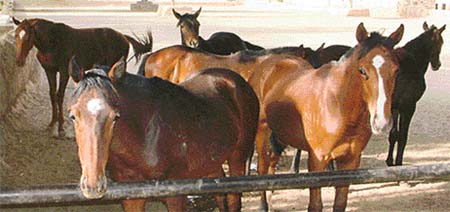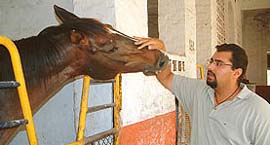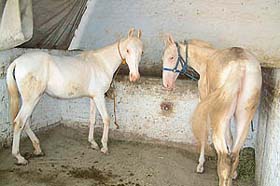
The gazette notification by the Government of India identifies 5 breeds of Indian horses as Marwari, Kathiyawari, Manipuri, Spiti and Zanskari.
1. MARWARI:
The Marwari Horse has acquired it's name from it's original breeding place Marwar in Rajasthan. The Marwari horse today is descended from the splendid war-horses that served the ruling families and warriors of feudal India, throughout and from the beginning of that country's history. Their std'us was unparalleled, as they were declared divine and superior to all men, including those of Royal blood. Accordingly, only the Rajput families and the Kshatriyas - warrior caste were permitted to mount these exalted animals. Today the breed is once again achieving eminence after over a century of twilight status due to the Imperial presence of the British and further, the new Indian democracy. Marwari horse, as the most potent symbol of the warrior Kings somehow survived wholesale slaughter, castration and fearful ignorance during the troubled times preceding Independence and for several decades later. It is thanks to the surviving Rajput families and horse lovers from all communities that the resilient and beautiful Marwari has emerged from the shadows onto a bright and hopeful future and out of the threat of extinction,
2. KATHIYAWARI:
The Kathiyawari has fhe same history as that of Marwari but having been bred in the Kathiyawar region of Gujarat , it acquires the name of Kathiyawari. Breeding line and environmental differences have distinctively given certain separate features to the Kathiyawari from it's cousin the Marwari. Such as ears, eyes, nose and in it's built up structure.
3. MANIPURI:
The Manipuri horses are bred in the north - eastern state of Manipur in India. The Manipuri has the best claim to fame, for it was the original polo pony. In the 1850's the English planters discovered this native game in India. They then took up and spread around the world. Physique of this horse is typical like that of pony but is very quick and maneuverable.
4. SPITI :
The Spiti horses are bred in the northern state of Himachal Pradesh in India. The name Spiti has been taken from the famous Spiti river. Physique of this horse is also like that of d pony, thick set and short coupled. They are very sure-footed and tough and used for transportation in the mountains.
5. ZANSKARI:
Zanskari horses are bred in the high altitude Zanskar region of Ladakh in eastern Jammu and Kashmir State of India. Physique of this horse is very similar to the Spiti pony but are more adaptable for higher altitude where they are used as work horses.
Most interesting:
Do Punjab stud farms make horse sense?
ACCORDING to an official announcement,"Punjab will have an equine farm, funded by the central government, to preserve and export the Sindhi breed of horses`85 Farmers can benefit by adopting horse-breeding as an allied profession." D. S. Jaspal, Financial Commissioner, Animal Husbandry Department, Punjab, maintains that since there is potential for the export of these horses, the government is keen to promote horse breeding and equestarian culture in the state. The intent notwithstanding, breeding of horses in private farms in the state does not present a very rosy picture. Though stud farms continue to exist, the profitability is low and the cost high. There is also no regulation for the desibreeds and export orders are virtually non-existent. Now, did some thought and horse sense go into this recent government announcement or is it just a move to hold out a carrot to dispirited farmers who have had nothing to look forward to since the cotton and potato crop debacle? Or, again, is it just a case of flogging a dead horse, read here a dull and slump-ridden breeding industry, which for the past decade has shown few signs of picking up pace? |
Breeding and racing are the two most lucrative reasons to invest in horses in the present age of motorised horse power, when horses have outrun their use as a means of transport and communication and even their significance in agriculture and other areas of life has been reduced considerably. While breeding Thoroughbreds (pure breds — see box) for racing requires big-time money and remains the sport of the super rich in the state, you find that a number of farmers, especially those in the Malwa region, have taken to producing indigenous breeds to supplement their unpredictable agricultural income. The business of Thoroughbreds and indigenous breeds may differ in terms of the care of horses, infrastructure and cost involved, purpose of breeding, rearing and selling but both suffer as a result of non-existent government support and lacunae in the system, hampering the flow of profits. Anil Mukhi, the country’s leading consultant in horse-breeding, says Punjab, which has at least a dozen of the 60 stud farms (of Thoroughbreds) existing in the country and offers at least 200 racehorses out of the 1300 produced in the country every year, has a natural advantage over the other states when it comes to the setting up of stud farms. Its fertile soil and green pastures help breed healthy racehorses at a low cost. Muktsar district, which boasts of the biggest stud farm in Punjab (owned by former Chief Minister Harcharan Singh Brar) and a couple of other medium and small-sized ones, comes only behind Pune in the production of racehorses. "Despite the large number of horses bred every year in the state, it’s a pity that there are no racecourses in the North except for the one in Delhi," says this Mumbai-based bloodstock agent. Punjab breeders have to travel hundreds of kilometres to Mumbai, Bangalore, Pune, Calcutta or Madras to sell their stock. "A market nearer home would certainly give a boost to the industry."
The high tax on betting is another bane of the horseracing industry, which offers a legal and organised system of gambling but whose potential has not been tapped fully by the government. Sunny Brar, son of Harcharan Singh Brar, who along with his three sons manages their 100-acre stud farm in Sarainaga village in Muktsar district, rues that the excessive tax on betting (40 per cent deducted at source) not only discourages prospective betters but has also led to an increase in the number of illegal bookies. The Brars, who took up horse breeding way back in 1973 with just two mares, are now the proud owners of about 100 mares, half a dozen stallions, and 75 foals. Besides breeding they also dabble in horse racing. Their 60 racehorses are being trained down South. Despite having 100 workers to man the livestock, Tegbir Brar, eldest son of Sunny Brar, says he and his brothers often have to take on the roles of genetic expert, paediatrician, gynaecologist, athletics coach, etc. An extreme shortage of trained personnel like vets, farriers, farm managers, fodder experts, jockeys, and trainers is felt in the region. Despondency can set in and even lead to packing up of the business if breeders meet with low returns. The 40-mare stud farm of former Punjab Minister Sukhdev Singh Dhillon at Rampurphul in Bathinda district had to be shut down in 1997 after operating for 16 years. The minister’s son Amardeep Singh Dhillon recalls, "Everything was sold on credit down South. We never got what we expected and thus ran into loss. Since the running cost of the stud farm cannot be decreased, we called it quits." There is little benefit in cutting corners to cut costs in this industry as that affects the quality of the produce. The family of Harbinder Singh Sidhu, which had migrated from Lahore in 1947, was among the first to set up a stud farm in Punjab in 1961 with two mares. The only other farm besides this belonged to Kanwar Manjitinder Singh of Faridkot, who then had about 10 to 20 mares. Fiftyeight-year-old Harbinder, who has been overseeing his Muktsar-based stud farm Mebojeona (which interestingly traces its pedigree —‘Me’ and ‘bojeona’— from Mehmadipur and Baddojeona, — names of two of the villages owned by his grandfather in Lahore.) for the past 31 years, says looking after horses has been a passion with him. This owner of 11 mares, one stallion and seven foals, says Punjab saw an overproduction of horses in the 1980s and there has been a slump in the industry since 1997. As a result, the chance breeders who had got into this game have been weaned away and now only a handful of serious breeders remain in the state. Even today the horse industry remains a buyers’ market, with the breeders holding little sway over it. Anil Mukhi puts the all-India demand for racehorses at 1000 per year — 300 short of the total countrywide production of 1300 athletes per year. India is exporting racehorses to Sri Lanka, Malaysia, Singapore, etc, and the indigenous Marwari breed to the USA for its ‘exotic’ value. The number exported, however, remains small. Interestingly, India which has suitable conditions for breeding horses, is flanked by the West Asian countries and Singapore, where the climate is not suitable for breeding. The government, however, has not tapped this export potential. Some 35 years ago, there had been a bar on exporting horses, as they had been afflicted with a disease. Since then three decades passed with the government making no effort to lift the restriction. Just about a year ago, the government made the effort to tell the world that its horses were safe, and orders from Singapore have been trickling in. But unless, says Mukhi, "we get Europe to agree to buy our horses, we’ll make no dent in the international market." Of late, this rich man’s sport is becoming accessible to a variety of people and income brackets as a result of syndicate buying, wherein up to eight buyers can get together to buy and race a horse and, finally, share the booty. Harbinder Sidhu’s son Surbirinder, manager in an MNC in Chandigarh, who shares his father’s passion for horses, says the yuppie crowd is showing enthusiasm for this sport. Last year, one of their racehorses was collectively bought by young executives. This limp industry requires young blood and new buyers, he feels. But more or less, horseracing continues to be the business of the rich. The ownership of the very best racehorses is still exclusively dominated by a handful of wealthy people. The owner’s name sells here and what matters is who he’s rubbing shoulders with. It is easy for established names like liquor baron Vijay Mallya and one of the biggest horse owners M.A. Ramasamy from the royal family of Chettinad (Madras) to strike deals. Horseracing, which came to India with the British and flourished with the coming up of 79 racecourses in pre-Independent India, has attracted little interest of the government except in terms of slapping a high tax on betting. Hong Kong, which offers a friendly tax policy and where one in every five persons bets on racing, generates a revenue out of horseracing without which the income tax would have to be increased by 6 per cent. Post-Independence, a number of racecourses — many of which were in a number of towns of old Punjab like Ambala, Faridkot, Amritsar, Karnal — have just left behind traces in the form of Racecourse Roads! The number of racetracks in the country now stands at just nine.
While the market for Thoroughbreds is registered, regulated and organised, the same cannot be said for the indigenous breeds like Marwari, Kathiyawari and Sindhi that find favour with farmers in Punjab. The two ghora mandis held in Muktsar during the Maghi mela (in January)and Dasehra, however, facilitate the buying and selling of the horses. The buyers come from not only all over Punjab but also other states like Delhi, Rajasthan, UP and even Mumbai. A number of horses are even picked up by the Bollywood people. The horse that fetches a handsome price (Rs 2 lakh to Rs 4 lakh) at these mandis is the nukra, whose white colour is considered auspicious in Hindu and Sikh marriages and other socio-religious occasions. The sale, breeding and ownership of desi breeds, however, continue to remain undocumented. Till now, there has been no export of horses from the state. The only efforts in this regard have been made by the Rajasthan-based Indigenous Horse Society of India (see box). Fortynine-year-old Harpal Singh, who along with his brothers owns 125 acres in Lakhewale village in Muktsar district, manages to make a tidy sum every year through horse-breeding. He owns 10 mares and sells four to five horses every year. While a desi coloured horse can bring anywhere between Rs 10,000 and Rs 60,000, it is the nukras which are known to change the fortunes of the horse-breeders. For most of the farmers who have taken to horse-breeding, a major chunk of the fodder ( chokker, jami, dana, khabbal) comes from the farm produce, thus cutting their overhead expenses. Despite this cost-saving measure, each horse uses about Rs 25,000 a year.
Horse-breeding, undoubtedly, is taken up with the desire to earn profits but if that is not backed by genuine regard and consideration for these sensitive animals, the whole venture can fall flat. Gurmail Singh, Revenue Patwari, Punjab, who is the proud owner of Moti, a Marwari which has won a number of awards besides the ‘champion horse’ title at the Punjab Equine Show last month, says fondness for the animal has made him opt for horse-breeding. The increase in aamdani has always remained a secondary issue with him. This rapport between the master and animal has been the fodder for many a legendary tale: when Alexander’s beloved warhorse Bucephalus died in a battle, he founded a city called Bucephala after him. And then, of course, there’s nothing more that can be written about the love, friendshp and companionship that Chetak and Maharana Pratap shared. Keeping this bonding in mind, Anil Mukhi expresses his reservations about the proposed equine farm in Punjab. Horses are individual characters which demand personalised care. Maintaining that a stud farm cannot be treated as a factory and he has yet to come across any such successful public sector project, he advises it would be better to keep stallions, which can be used by horse-breeders to service their mares. The flagging industry can be promoted by displaying our mounts in the international market and harnessing export orders for them. Photos by Kulbir Beera |





Nice posting! I love the ears from the horse ;-) And that without glue!
AntwortenLöschenWhile stud farms in Europe struggle to survive, the punjabi government thinks of establishing a breeding station! Funny, isn't it!
AntwortenLöschenYes, it's weird! But it is sad, that here in Europe some things are struggling to survive! Not fare !!
AntwortenLöschen
AntwortenLöschenThings are struggling to survive everywhere. The horse industry all over the world has taken a very hard hit. From breeding farms to show barns to the local riding stable, many are in serious trouble. The cost of feed, bedding, vet bills, energy costs have skyrocketed and there is only so much you can charge your equally hard hit clients. Some people are hit with the decision of continuing to pay horse related bills or paying for mortgage and food for their families. It will get better, but slowly.
Romy
Do the nukra look like albino horses to you? I can't tell what color their eyes are in the picture.
AntwortenLöschenRomy
Interesting article. Something about profit and revenue being the primary goal when it comes to horses always makes me a little sad.
AntwortenLöschenromyromy1 speaks the truth-- stabling costs are out of reach in many areas. I also think things willl come around, but it will take some time--
AntwortenLöschenComing from Thailand I cannot say anything intelligent enough about horses except that only the (very) rich people can own (good) horses. Thanks for the article. Have been enlightened by the comments above, too.
AntwortenLöschen